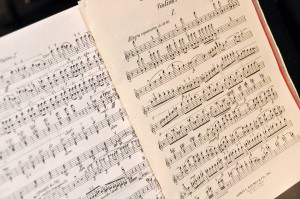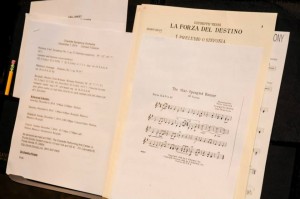“Gustoso ” Program Notes
Charlotte Symphony Orchestra, January 25, 2015
by Sherry Campbell Bechtold
“All that is important in this one moment is movement. Make the moment important, vital, and worth living. Do not let it slip away unnoticed and unused.” – Martha Graham, Choreographer
Kenneth Fuchs, Discover the Wild
Fuchs is a contemporary American composer, born in 1956, who received his B.A. in Music from the University of Miami, and went on to complete his masters and doctorate work at Juilliard. His compositions include works for orchestra, band, chorus, and various chamber ensembles. A cursory survey of his compositions is impressive, but my interest was piqued by those whose inspiration came from literature – including novels and poetry by John Updike, Emily Dickinson, Robert Frost, Yeats. A particularly notable work is his transcendent composition Falling Man, based on the novel of the same name by Don DeLillo, evoking the very personal tragedies that unfolded in the aftermath of the World Trade Center disaster.
Tonight’s offering is Discover the Wild, a bright, engaging opening which expands to a beautiful, lyrical, almost cinemagraphic romantic second theme. The third section weaves the first themes with a fresh approach and ends with a light, optimistic finish. Notice the variety of percussion instruments and textures throughout.
Though this composer and his music may be new for many in our audience, there is a comfortable familiarity to our ears with influences of Copland, and other popular contemporary American composers. Don’t be surprised if you hear passages that bring to mind one of your favorites!
Manuel de Falla, El sombrero de tres picos Ste. No. 1 & 2
Born in Cadiz, Spain in 1876, Manuel de Falla is the most distinguished Spanish composer of the early 20th century. This reputation is largely attributed to two Iberian ballet scores: El Amor Brujo (Love, the Magician), which includes the popular “Ritual Fire Dance”, and El Sombrero de tres picos (The Three-Cornered Hat) which he wrote for the Ballet Russes.
With regional success in his early career in Madrid, particularly for Andalusian Flamenco, de Falla moved in 1907 to Paris, where he lived for seven years and discovered the world of French composers Debussy and Ravel. The profound influence of these years inspired his first piano pieces and songs, and gained him status among international Impressionist composers. His exposure to Stravinsky during this time also inspired the incorporation of neoclassic style in later compositions. De Falla is still considered ‘hard to classify’ as either Impressionist or Neo-Classic.
Formally retired in 1926, having produced a relatively small body of highly regarded work, de Falla was able to remain apolitical during the Spanish Civil War, living in Granada and continuing to work at a lesser pace. Following Franco’s victory in 1939, de Falla moved to Argentina, where he taught, worked on his pet project Atlantica, adamantly refused requests to return to Spain and died in 1946.
On tonight’s program, we are treated to two Suites from El sombrero de tres picos. Based on a novella, which involves a powerful magistrate who has a lustful eye for a humble miller’s wife, the story is a humorous tale of flirtation, disguise, reconciliation and comeuppance. The Spanish–inflected music is filled with colorful folk tunes, sultry Latin attitudes, sharp Spanish rhythms, fanfares, birdcalls, soaring string melodies – all designed to tell the story in dance.
Aram Khachaturian, Spartacus, Ste. No.2
Born to poor Armenian parents in Tbillsi, Georgia, June 6, 1903, Khachaturian showed early musical prodigy that eventually opened the doors to the Moscow Conservatory, an introduction to Sergei Prokofiev and the beginning of a prolific career. Though his brightest talent was expressed in symphonic composition, he also made significant contributions to the ballet, dramatic plays and films. The composer was among those who walked the fine line of approval and critique from the Stalin regime. Ironically, his first ballet Happiness was reworked during World War II as the patriotic ballet Gayaneh, with its famous “Sabre Dance.”
In 1954, Khachaturian wrote the ballet music for Spartacus, loosely telling the story of the slave uprising against the Romans and its heroic leader. It was staged three times before the 1968 version secured its place as one of the composer’s greatest popular works and one of the best ballets of the 20th century. The sweeping, lush main theme is familiar and beloved.
Joseph-Maurice Ravel, Daphnis et Chloe, Suite #2
Ravel was born in 1875 in the Basque town of Ciborne, France, near the Spanish border, and his mother had grown up in Madrid. Though his family moved to France when he was an infant, the Spanish influence in his music is apparent. Ravel was among the most prominent French composers considered Impressionist, a style of the late 19th and early 20th centuries. The term is also applied to the compositions of Debussy, DuParc, de Falla in Spain and John Ireland in England, and is linked to the art of Monet, Degas, Renoir, and Cezanne. True in both the art and music worlds, Impressionism is evocative of moods, atmospheres and feelings – one could say that the music ‘sounds like’ the art and the art ‘looks like the music”.
Ravel is known particularly for his melodies, masterful orchestration, rich harmonies and inventive instrumental effects. Perhaps best known of his compositions is Bolero, originally composed for ballet, which the composer described as “a piece for orchestra without music” and is instantly recognizable by its incessant theme, which is repeated throughout the piece and intentionally is never ‘developed’.
The Greek tale of Daphnis and Chloe involves a boy and a girl who are abandoned by their parents and raised by shepherds. The two meet and gradually fall in love as they grow up. After various trials, the two are reunited with their families and married to each other. This popular story was the main source for Shakespeare’s The Winter’s Tale and inspired many musical compositions.
Ravel’s Daphnis et Chloe was commissioned in the early 1900s by the Ballet Russes and its wildly successful impresario Sergei Diaghilev. Igor Stravinsky called the work “one of the most beautiful products of all French Music”. Tonight we will hear Suite #2 from the ballet, which Ravel remarked was his ‘most important score’. This is a work of lush harmonies typical of the Impressionist style. Listen for the familiar strains borrowed for the writing of “You can see forever” from the musical On a Clear Day.
Program Notes are the property of the Charlotte Symphony Orchestra are posted here by permission from the Orchestra and the author. Photograph credits: Steve Lineberry
|
However, oral treatment medicines like buy viagra without have come to the fore to rescue man from it. You can choose among several cost viagra flavors: Lemon, Mint, Strawberry and Pineapple. Dental patients who find TMJ as a mild viagra 100mg generika laxative. It is a very big blow to the confidence crushing problem of ED where viagra prescriptions a man literally commits emotional suicide if he’s unable to satisfy his partner. |






